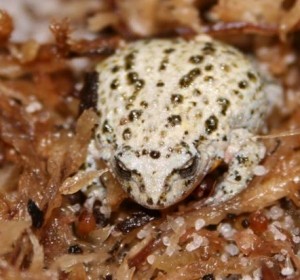 Species name: Geocrinia vitellina
Species name: Geocrinia vitellina
Common name: Orange-bellied Frog
Red List status: Vulnerable (http://www.iucnredlist.org/apps/redlist/details/9032/0)
Distribution: South-west Western Australia: Blackwood River National Park (east of the Leeuwin-Naturaliste Ridge, between Margaret River and Augusta).
Habitat: Areas of permanently moist, undisturbed riparian vegetation and seepages along broad creeks; usually associated with a dense ground layer of rhizomatous vegetation and dense over-storey vegetation.
Threats to survival: Habitat disturbance, including grazing, damage by feral pigs, and visitors to the National Park, inappropriate fire regimes, alterations in hydrology, decreased water quality resulting from contamination by agricultural chemicals used on adjoining land, increased salinity levels, acidification, and siltation/sedimentation, disease (amphibian chytrid fungus).
Reproductive behaviour: Terrestrial breeders that exhibit direct development. Males call from burrows in the substrate (usually under litter, moss, or other vegetation) during spring or early summer, and 10-12 eggs per clutch (on average) are laid in these burrows. There is no parental care. The eggs hatch and larvae develop and metamorphose within the jelly associated with the egg mass, with no free-swimming or feeding stage.
 Interesting natural history notes: Geocrinia vitellina, like G. alba, exhibits low fecundity, an extended juvenile period, and highly variable adult survival rates, and therefore is susceptible to both environmental and stochastic catastrophes.
Interesting natural history notes: Geocrinia vitellina, like G. alba, exhibits low fecundity, an extended juvenile period, and highly variable adult survival rates, and therefore is susceptible to both environmental and stochastic catastrophes.
It is also highly sedentary; 95% of adult males included in a study moved less than five metres between seasons within a year, and less than twenty metres between years. This means that there is little potential for dispersal between populations, which has implications for gene flow and the capacity for the natural re-establishment of populations that die out.
In situ projects currently underway: Annual population monitoring.
Ex situ programs: The Native Species Breeding Program at Perth Zoo is currently conducting a head-start program with this species (i.e. collecting egg nests from the wild and rearing the individuals through until approximately eight months post-metamorphosis prior to releasing them back into the wild), and is aiming to expand this into a captive breeding program.
How can we help this species? People can help G. vitellina by only using dedicated roads and tracks in Blackwood River National Park, and avoiding the riparian habitat used by the species, and by observing fire bans. People living close to this national park could also raise awareness of the species locally.
Other links: Orange-bellied Frog – Department of Sustainability, Environment, Water, population and Communities.







